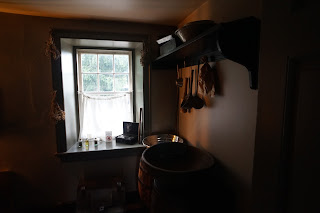It didn’t take long for something to catch his attention. At a booth marked "Baby Doll," a woman sat behind a table covered in intricate dream catchers, her hands moving with quiet precision as she wove threads and feathers together. Above her, a rainbow of dream catchers hung like a canopy, their vibrant colours swaying gently in the breeze.
Without thinking twice, Bob lifted his camera and clicked the shutter, capturing the scene. He didn’t stop to ask, didn’t think to engage. After all, he’d done this a hundred times before. The beauty of street photography, to Bob, was in its candidness, in the rawness of moments stolen without anyone noticing.
But the woman noticed.
Her hands paused mid-weave, and she looked up. A brief flicker of confusion crossed her face before her eyes narrowed slightly, locking onto Bob. She didn’t say anything at first, just stared, her lips pressed into a firm line. Bob, oblivious to her reaction, had already moved on, his focus now on another vendor a few stalls down.
"Excuse me!" The woman's voice rang out, cutting through the market's background noise. Bob froze.
He turned around slowly, spotting the woman standing up from her booth. She wasn’t exactly angry, but there was something in her stance that made Bob feel uneasy.
"You just took my picture," she said, her tone direct but controlled.
Bob blinked, surprised she’d noticed. "Yeah, uh... I’m doing street photography. Just capturing the market, you know?"
She crossed her arms, her face hardening. "But you didn’t ask."
Bob felt the familiar defences rising. "It’s a public space. You’re part of the scene. I didn’t mean any harm."
The woman shook her head. "It’s not about harm. It’s about respect. I’m sitting here, working, and you just took my photo without even acknowledging me. How would you feel if I did the same to you?"
Bob opened his mouth to respond, but then realised he didn’t have much to say. The thrill of getting the shot was fading fast, replaced by an uncomfortable weight in his chest. She had a point. It was legal, sure, but legal wasn’t the same as right.
"I... I didn’t think about it like that," Bob admitted, lowering his camera slightly.
"Yeah, well, maybe you should," she said. Her tone wasn’t harsh, but it carried a quiet authority. She turned and went back to her table, her hands resuming their work as if the moment hadn’t happened.
Bob stood there for a second, awkwardly lingering. The crowd moved around him, the market carrying on as usual, but something had shifted. The thrill of candid shots felt a little hollow now. As he walked away, his camera hanging unused around his neck, Bob couldn’t shake the feeling that some moments were meant to be shared, not taken.
Later, as he sat at home reviewing the day’s photos, he found the one he’d taken of the woman. The composition was perfect—the dream catchers framed her beautifully, and the colours popped against the white of her booth. But Bob couldn’t stop thinking about their interaction.










